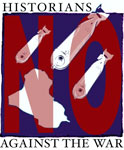Binghamton University Teach-In, October 18
We held our teach-in at Binghamton University at 8:00 P.M. on Wednesday, October 18 and felt it was successful beyond our most optimistic expectations. The event drew an audience of more than 150 people, primarily students and faculty, but with a significant number of community people. Four speakers from the History Department made presentations:
Donald Quataert, “Iraq and Its Neighbors”
Thomas Dublin, “How the U.S. Got In, and What It Means”
Kathryn Kish Sklar, “Why Is the U.S. Military Budget So Large?”
Herbert Bix, “The Case for Withdrawal”
The four presentations lasted about an hour and they were followed by about 45 minutes of discussion, questions, and comments from members of the audience. In addition, there were two videographers recording the event, which will be aired on a public-access station on the local cable TV system. In addition, there was excellent coverage from the local newspaper and at least one television station as well as the Binghamton University student paper. There had been good publicity for the event in advance and the size of the audience and the media attention reflected that fact. I think we all felt that the time was ripe for the event and that in Binghamton there are a lot of people eager to support the antiwar cause.
The discussion that followed the presentations provided further evidence of the general interest and concern. Questions provided good back and forth on the analysis offered, prospects for the future, what can be done to turn things around. While a variety of perspectives were represented, there was a sense of optimism at the gathering, a general belief that the administration’s policy is discredited and that the American people are increasingly willing and able to oppose the war. There is considerable hope that the upcoming elections can make a difference and place Bush and others on the defensive. People left the meeting energized.
Tom Dublin,
History Department
Binghamton University
Donald Quataert, “Iraq and Its Neighbors”
Thomas Dublin, “How the U.S. Got In, and What It Means”
Kathryn Kish Sklar, “Why Is the U.S. Military Budget So Large?”
Herbert Bix, “The Case for Withdrawal”
The four presentations lasted about an hour and they were followed by about 45 minutes of discussion, questions, and comments from members of the audience. In addition, there were two videographers recording the event, which will be aired on a public-access station on the local cable TV system. In addition, there was excellent coverage from the local newspaper and at least one television station as well as the Binghamton University student paper. There had been good publicity for the event in advance and the size of the audience and the media attention reflected that fact. I think we all felt that the time was ripe for the event and that in Binghamton there are a lot of people eager to support the antiwar cause.
The discussion that followed the presentations provided further evidence of the general interest and concern. Questions provided good back and forth on the analysis offered, prospects for the future, what can be done to turn things around. While a variety of perspectives were represented, there was a sense of optimism at the gathering, a general belief that the administration’s policy is discredited and that the American people are increasingly willing and able to oppose the war. There is considerable hope that the upcoming elections can make a difference and place Bush and others on the defensive. People left the meeting energized.
Tom Dublin,
History Department
Binghamton University


0 Comments:
Post a Comment
<< Home